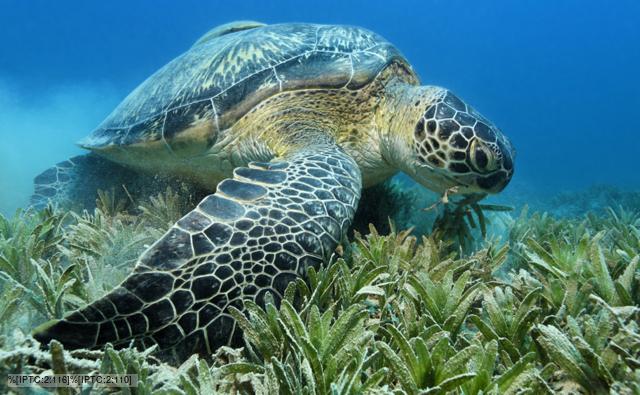Out on our second coral reef dive several of us had been up on the boat trying not to hurl or fighting heat exhaustion when someone notices a juvenile sea turtle! The second I heard those words I knew that I had to jump in and try to get some footage of it. As I scrambled to get my fins and snorkel i quickly jumped in the water and swam as fast as I could after it. By the time I got out there the turtle had disappeared from the surface and has descended somewhere down below. After a little searching I finally found it and dove down to get a closer look and get the scoop on green sea turtles. I was able to identify the turtle because there was only one pair of prefrontal scales and the shape and color of the shell. In order to get more information I asked the sea turtle a few questions...
Question #1: Where did you get the name green sea turtle?
Most people are surprised to find out that green sea turtles do not get their name because of the color of their shells which are usually and olive or a brown. They get their name because of the green color in their fat layer. Unlike the other sea turtles adult greens eat sea grasses and algae, making them herbivorous. The juveniles like me will sometimes snack on invertebrates as well.
 |
| A green sea turtle feeding on seagrass |
Question #2: How old can you grow to be?
We are not your average animal and have a very long lifespan. As long as I remain healthy and don't run into any plastic bags or balloons I could live to be as old as 100 years or possibly more! Sea turtles do not reach sexual maturity until at least 20-50 years of age. Being a juvenile I clearly have a long live ahead of me. But be sure to help keep our oceans CLEAN AND GARBAGE FREE!!!!!! We are an endangered species and since we don't reach sexual maturity until later in our lives it is very important that the young survive long enough to reproduce or else we won't see an increase in the green sea turtle population.
Question #3: What brings you here to Florida?
Unlike the turtles you see around the beaches and roads in New Jersey I require much warmer temperatures and sometimes adults nest on beaches here. If you see a turtle on land in New Jersey it is NOT a sea turtle, you are most likely seeing a diamondback terrapin. Females will return to the same nesting beach in order to lay her clutches of eggs. Although if you are lucky you may see us pop through during the summer months but only out in the ocean passing through. We like warm tropical and subtropical waters which is why the Florida reefs is the perfect place for me to hang out. Plenty of food and the water is so toasty warm. I'm glad you migrated your way down to Florida so that we could meet.
 |
| Hey guys! I hope you are enjoying your class in Florida |
Interested in sea turtles? Learn more here
Want to learn what you can do to help get them off the endangered species list, check out this flyer!

That graphic on sea turtle ID is great! I always have trouble differentiating between a hawksbill and green at first. This will make it make it much easier next time.
ReplyDeleteSea turtles are one of my favorite animals. They truly are so beautiful and majestic. I loved your interpretation of an interview with a green sea turtle. I learned things from reading your interview that I hadn't previously known about sea turtles before and I love the pictures you included!
ReplyDeleteI am absolutely in love with sea turtles and would love to work with them one day. The ID was great because i always have a problem with telling them apart except for the Kemp ridley's and the leatherbacks.
ReplyDelete